Inducing Evapotranspiration Reduction in an Engineered Natural System to Manage Saltcedar in Riparian Areas of Arid Environments
Abstract
:1. Introduction
2. Materials and Methods
2.1. Experimental Site
2.2. Management of Saltcedar
2.3. Evapotranspiration Measurement
2.3.1. Energy Budget and Eddy Covariance Method
2.3.2. Instrumentation
2.4. Groundwater
2.5. Vegetation Index
2.6. Statistical Analysis
3. Results
3.1. Evapotranspiration
3.2. Groundwater Measurements
3.3. Normalized Vegetation Difference Index Measurements
3.4. Climate
4. Discussion
5. Conclusions
Author Contributions
Funding
Data Availability Statement
Acknowledgments
Conflicts of Interest
References
- McDaniel, K.C.; DiTomaso, J.M.; Duncan, C.A. Tamarisk or saltcedar, Tamarix spp. In Assessing the Economic, Environmental and Societal Losses from Invasive Plants on Rangeland and Wildlands; Clark, J.K., Duncan, C.L., Eds.; Weed Science Society of America: Champaign, IL, USA, 2005; pp. 198–222. [Google Scholar]
- Taylor, J.P.; McDaniel, K.C. Restoration of Saltcedar (Tamarix Spp.)-Infested Floodplains on the Bosque Del Apache National Wildlife Refuge. Weed Technol. 1998, 12, 345–352. [Google Scholar] [CrossRef]
- Brotherson, J.D.; Field, D. Tamarix: Impacts of a Successful Weed. Rangelands 1987, 9, 110–112. [Google Scholar]
- Di Tomaso, J.M. Impact, Biology, and Ecology of Saltcedar (Tamarix Spp.) in the Southwestern United States. Weed Technol. 1998, 12, 326–336. [Google Scholar] [CrossRef]
- Carruthers, R.I.; Deloach, C.J.; Herr, J.C.; Anderson, G.L.; Knutson, A.E. Salt Cedar Areawide Pest Management in the Western USA. In Areawide Pest Management: Theory and Implementation; Koul, O., Cuperus, G.W., Elliott, N., Eds.; CABI: Wallingford, UK, 2008; pp. 271–299. [Google Scholar]
- Culler, R.C.; Hanson, R.L.; Myrick, R.M.; Turner, R.; Kipple, F. Evapotranspiration before and after Clearing Phreatophytes, Gila River Flood Plain, Graham County, Arizona; United States Geological Survey: Reston, VA, USA, 1982. [Google Scholar]
- Devitt, D.A.; Sala, A.; Smith, S.D.; Cleverly, J.; Shaulis, L.K.; Hammett, R. Bowen Ratio Estimates of Evapotranspiration for Tamarix ramosissima Stands on the Virgin River in Southern Nevada. Water Resour. Res. 1998, 34, 2407–2414. [Google Scholar] [CrossRef]
- Cleverly, J.R.; Dahm, C.N.; Thibault, J.R.; Gilroy, D.J.; Allred Coonrod, J.E. Seasonal Estimates of Actual Evapo-Transpiration from Tamarix Ramosissima Stands Using Three-Dimensional Eddy Covariance. J. Arid Environ. 2002, 52, 181–197. [Google Scholar] [CrossRef]
- Bawazir, A.S.; King, J.P.; Kidambi, S.; Tanzy, B.; Stowe, N.H.; Fahl, M.J. A Joint Investigation of Evapotranspiration Depletion of Treated and Non-Treated Saltcedar at the Elephant Butte Delta, New Mexico; New Mexico Water Resources Research Institute: Las Cruces, NM, USA, 2006. [Google Scholar]
- Westenburg, C.L.; Harper, D.P.; DeMeo, G.A. Evapotranspiration by Phreatophytes along the Lower Colorado River at Havasu National Wildlife Refuge, Arizona; United States Geological Survey: Reston, VA, USA, 2006. [Google Scholar]
- Hart, C.R.; White, L.D.; McDonald, A.; Sheng, Z. Saltcedar Control and Water Salvage on the Pecos River, Texas, 1999–2003. J. Environ. Manag. 2005, 75, 399–409. [Google Scholar] [CrossRef]
- Ostoja, S.M.; Brooks, M.L.; Dudley, T.; Lee, S.R. Short-Term Vegetation Response Following Mechanical Control of Saltcedar (Tamarix Spp.) on the Virgin River, Nevada, USA. Invasive Plant Sci. Manag. 2014, 7, 310–319. [Google Scholar] [CrossRef]
- González, E.; Sher, A.A.; Anderson, R.M.; Bay, R.F.; Bean, D.W.; Bissonnete, G.J.; Bourgeois, B.; Cooper, D.J.; Dohrenwend, K.; Eichhorst, K.D.; et al. Vegetation Response to Invasive Tamarix Control in Southwestern U.S. Rivers: A Collaborative Study Including 416 Sites. Ecol. Appl. 2017, 27, 1789–1804. [Google Scholar] [CrossRef]
- Taylor, J.P.; McDaniel, K.C. Riparian Management On The Bosque Del Apache National Wildlife Refugee. N. M. J. Sci. 1998, 38, 219–232. [Google Scholar]
- Natale, E.; Sorli, L.; De La Reta, M.; Coria, G.; Zilio, M.; Arana, M.D.; Aros, L.; Estive, F.; Palma, M.; Oggero, A.J. Basis for Restoration of Saltcedar (Tamarix Spp., Tamaricaceae) Invaded Sites through an Adaptive Management Approach. J. Nat. Conserv. 2022, 68, 126230. [Google Scholar] [CrossRef]
- Shafroth, P.B.; Brown, C.A.; Merritt, D.M. Saltcedar and Russian Olive Control Demonstration Act Science Assessment; United States Geological Survey: Reston, VA, USA, 2010. [Google Scholar]
- McDaniel, K.C.; Taylor, J.P. Saltcedar Recovery after Herbicide-Burn and Mechanical Clearing Practices. J. Range Manag. 2003, 56, 439–445. [Google Scholar] [CrossRef]
- Fick, W.H.; Geyer, W.A. Cut-Stump Treatment of Saltcedar (Tamarix ramosissima) on the Cimarron National Grasslands. Trans. Kans. Acad. Sci. 2010, 113, 223–226. [Google Scholar] [CrossRef]
- Duncan, K.W.; McDaniel, K.C. Saltcedar (Tamarix Spp.) Management with Imazapyr. Weed Technol. 1998, 12, 337–344. [Google Scholar] [CrossRef]
- McDaniel, K.C.; Taylor, J.P. Aerial Spraying and Mechanical Saltcedar Control. In Saltcedar and Water Resources in the West Symposium; The Texas Agricultural Experiment Station: San Angelo, TX, USA, 2003; pp. 100–105. [Google Scholar]
- Duncan, K.W. Individual Plant Treatment of Saltcedar. In Saltcedar and Water Resources in the West Symposium; Texas Agricultural Experiment Station: San Angelo, TX, USA, 2003; pp. 106–110. [Google Scholar]
- Douglass, C.H.; Nissen, S.J.; Kniss, A.R. Efficacy and Environmental Fate of Imazapyr from Directed Helicopter Applications Targeting Tamarix Species Infestations in Colorado: Helicopter Imazapyr Applications to Control Tamarix spp. Pest. Manag. Sci. 2016, 72, 379–387. [Google Scholar] [CrossRef] [PubMed]
- DeLoach, C.J.; Carruthers, R.I.; Dudley, T.L.; Eberts, D.; Kazmer, D.J.; Knutson, A.E.; Bean, D.W.; Knight, J.; Lewis, P.A.; Milbrath, L.R.; et al. First Results for Control of Saltcedar (Tamarix spp.) in the Open Field in the Western United States. In XI International Symposium on Biological Control of Weeds; CSIRO Entomology: Canberra, Australia, 2004; pp. 505–513. [Google Scholar]
- Hudgeons, J.L.; Knutson, A.E.; Heinz, K.M.; DeLoach, C.J.; Dudley, T.L.; Pattison, R.R.; Kiniry, J.R. Defoliation by Introduced Diorhabda Elongata Leaf Beetles (Coleoptera: Chrysomelidae) Reduces Carbohydrate Reserves and Regrowth of Tamarix (Tamaricaceae). Biol. Control 2007, 43, 213–221. [Google Scholar] [CrossRef]
- Zavaleta, E. Valuing Ecosystem Services Lost to Tamarix Invasion in the United States. In Invasive Species in A Changing World; Mooney, H.A., Hobbs, R.J., Eds.; Island Press: Washington DC, USA, 2000; pp. 261–300. [Google Scholar]
- Taylor, J.P.; McDaniel, K.C. Revegetation Strategies After Saltcedar (Tamarix spp.) Control in Headwater, Transitional, and Depositional Watershed Areas. Weed Technol. 2004, 18, 1278–1282. [Google Scholar]
- Barz, D.; Watson, R.P.; Kanney, J.F.; Roberts, J.D.; Groeneveld, D.P. Cost/Benefit Considerations for Recent Saltcedar Control, Middle Pecos River, New Mexico. Environ. Manag. 2009, 43, 282–298. [Google Scholar] [CrossRef]
- Weeks, E.P.; Weaver, H.L.; Campbell, G.S.; Tanner, B.D. Water Use by Saltcedar and by Replacement Vegetation in the Pecos River; United States Geological Survey: Reston, VA, USA, 1987. [Google Scholar]
- Jensen, M.E.; Burman, R.D.; Allen, R.G. Evapotranspiration and Irrigation Water Requirements: A Manual; American Society of Civil Engineers, Ed.; ASCE manuals and reports on engineering practice; The Society: New York, NY, USA, 1990; ISBN 9780872627635. [Google Scholar]
- Dingman, S.L. Physical Hydrology; Prentice-Hall, Inc.: Upper Saddle, NJ, USA, 2002. [Google Scholar]
- Brutsaert, W. Hydrology: An Introduction; Cambridge University Press: Cambridge, UK, 2005. [Google Scholar]
- Tanzy, B.F. (United States Bureau of Reclamation, Elephant Butte, NM, USA). Personal Communication. 2008. [Google Scholar]
- Williams, J.L. New Mexico in Maps, 2nd ed.; Universtiy of New Mexico Press: Albuquerque, NM, USA, 1986. [Google Scholar]
- Samani, Z.; Bawazir, A.S.; Bleiweiss, M.; Skaggs, R.; Longworth, J.; Tran, V.D.; Pinon-Villarreal, A. Using Remote Sensing to Evaluate the Spatial Variability of Evapotranspiration and Crop Coefficient in the Lower Rio Grande Valley, New Mexico. Irrig. Sci. 2009, 28, 93–100. [Google Scholar] [CrossRef]
- Eshonkulov, R.; Poyda, A.; Ingwersen, J.; Wizemann, H.D.; Weber, T.K.; Kremer, P.; Hogy, P.; Pulatov, A.; Streck, T. Evaluating Multi-Year, Multi-Site Data on the Energy Balance Closure of Eddy-Covariance Flux Measurements at Cropland Sites in Southwestern Germany. Biogeosciences 2019, 16, 521–540. [Google Scholar] [CrossRef]
- Bawazir, A.S.; Samani, Z.; Bleiweiss, M.; Skaggs, R.; Schmugge, T. Using ASTER Satellite Data to Calculate Riparian Evapotranspiration in the Middle Rio Grande, New Mexico. Int. J. Remote Sens. 2009, 30, 5593–5603. [Google Scholar] [CrossRef]
- Allen, R.G.; Pereira, L.S.; Howell, T.A.; Jensen, M.E. Evapotranspiration Information Reporting: I. Factors Governing Measurement Accuracy. Agric. Water Manag. 2011, 98, 899–920. [Google Scholar] [CrossRef]
- Blanford, J.H.; Gay, L.W. Tests of a Robust Eddy Correlation System for Sensible Heat Flux. Theor. Appl. Clim. 1992, 46, 53–60. [Google Scholar] [CrossRef]
- Swinbank, W.C. The Measurement of Vertical Transfer of Heat and Water Vapor by Eddies in the Lower Atmosphere. J. Meteor. 1951, 8, 135–145. [Google Scholar] [CrossRef]
- Amiro, B.D.; Wuschke, E.E. Evapotranspiration from a Boreal Forest Drainage Basin Using an Energy Balance/Eddy Correlation Technique. Bound.-Layer Meteorol. 1987, 38, 125–139. [Google Scholar] [CrossRef]
- Schmid, H.P. Footprint Modeling for Vegetation Atmosphere Exchange Studies: A Review and Perspective. Agric. For. Meteorol. 2002, 113, 159–183. [Google Scholar] [CrossRef]
- Kljun, N.; Calanca, P.; Rotach, M.W.; Schmid, H.P. A Simple Parameterisation for Flux Footprint Predictions. Bound.-Layer Meteorol. 2004, 112, 503–523. [Google Scholar] [CrossRef]
- Abudu, S.; Bawazir, A.S.; King, J.P. Infilling Missing Daily Evapotranspiration Data Using Neural Networks. J. Irrig. Drain Eng. 2010, 136, 317–325. [Google Scholar] [CrossRef]
- Tucker, C.J.; Fung, I.Y.; Keeling, C.D.; Gammon, R.H. Relationship between Atmospheric CO2 Variations and a Satellite-Derived Vegetation Index. Nature 1986, 319, 195–199. [Google Scholar] [CrossRef]
- Lenney, M.P.; Woodcock, C.E.; Collins, J.B.; Hamdi, H. The Status of Agricultural Lands in Egypt: The Use of Multitemporal NDVI Features Derived from Landsat TM. Remote Sens. Environ. 1996, 56, 8–20. [Google Scholar] [CrossRef]
- Nemani, R.R.; Keeling, C.D.; Hashimoto, H.; Jolly, W.M.; Piper, S.C.; Tucker, C.J.; Myneni, R.B.; Running, S.W. Climate-Driven Increases in Global Terrestrial Net Primary Production from 1982 to 1999. Science 2003, 300, 1560–1563. [Google Scholar] [CrossRef]
- Donohue, R.J.; McVICAR, T.R.; Roderick, M.L. Climate-related Trends in Australian Vegetation Cover as Inferred from Satellite Observations, 1981–2006. Glob. Change Biol. 2009, 15, 1025–1039. [Google Scholar] [CrossRef]
- Gandhi, G.M.; Parthiban, S.; Thummalu, N.; Christy, A. Ndvi: Vegetation Change Detection Using Remote Sensing and Gis—A Case Study of Vellore District. Procedia Comput. Sci. 2015, 57, 1199–1210. [Google Scholar] [CrossRef]
- Adler-Golden, S.M.; Matthew, M.W.; Bernstein, L.S.; Levine, R.Y.; Berk, A.; Richtsmeier, S.C.; Acharya, P.K.; Anderson, G.P.; Felde, J.W.; Gardner, J.A.; et al. Atmospheric Correction for Shortwave Spectral Imagery Based on MODTRAN4; Descour, M.R., Shen, S.S., Eds.; SPIE: Denver, CO, USA, 1999; pp. 61–69. [Google Scholar]
- Kaufman, Y.J.; Tanré, D.; Gordon, H.R.; Nakajima, T.; Lenoble, J.; Frouin, R.; Grassl, H.; Herman, B.M.; King, M.D.; Teillet, P.M. Passive Remote Sensing of Tropospheric Aerosol and Atmospheric Correction for the Aerosol Effect. J. Geophys. Res. 1997, 102, 16815–16830. [Google Scholar] [CrossRef]
- Kljun, N.; Rotach, M.W.; Schmid, H.P. A Three-Dimensional Backward Lagrangian Footprint Model For A Wide Range Of Boundary-Layer Stratifications. Bound.-Layer Meteorol. 2002, 103, 205–226. [Google Scholar] [CrossRef]
- Allen, R.G. The ASCE Standardized Reference Evapotranspiration Equation; Environmental and Water Resources institute (U.S.), Ed.; American Society of Civil Engineers: Reston, VA, USA, 2005; ISBN 9780784408056. [Google Scholar]
- Sheppard, P.; Comrie, A.; Packin, G.; Angersbach, K.; Hughes, M. The Climate of the US Southwest. Clim. Res. 2002, 21, 219–238. [Google Scholar] [CrossRef]
- Bawazir, A.S. Saltcedar and Cottonwood Riparian Evapotranspiration in the Middle Rio Grande. Ph.D. Dissertation, New Mexico State University, Las Cruces, NM, USA, 2000. [Google Scholar]
- Blaney, H.F.; Hanson, E.G. Consumptive Use and Water Requirements in New Mexico; New Mexico State Engineer Office; Santa Fe, NM, USA, 1965; pp. 1–82 & 3 folded maps.
- Lair, K.D. Revegetation Strategies and Technologies for Restoration of Aridic Saltcedar (Tamarix spp.) Infestation Sites. In Proceedings of the National Proceedings: Forest and Conservation Nursery Associations—2005, Fort Collins, CO, USA, 26–28 July 2005; U.S. Department of Agriculture Forest Service: Washington, DC, USA, 2006; pp. 10–20. [Google Scholar]
- Grundy, A.C.; Bond, B. Use of Non-Living Mulches for Weed Control. In Non-Chemical Weed Management: Principles, Concepts and Technology; Blackshaw, R.E., Upadhyaya, M.K., Eds.; CABI: Wallingford, UK, 2007. [Google Scholar]
- Snyder, K.A.; Scott, R.L.; McGwire, K. Multiple Year Effects of a Biological Control Agent (Diorhabda carinulata) on Tamarix (Saltcedar) Ecosystem Exchanges of Carbon Dioxide and Water. Agric. For. Meteorol. 2012, 164, 161–169. [Google Scholar] [CrossRef]
- Nagler, P.L.; Pearlstein, S.; Glenn, E.P.; Brown, T.B.; Bateman, H.L.; Bean, D.W.; Hultine, K.R. Rapid Dispersal of Saltcedar (Tamarix Spp.) Biocontrol Beetles (Diorhabda carinulata) on a Desert River Detected by Phenocams, MODIS Imagery and Ground Observations. Remote Sens. Environ. 2014, 140, 206–219. [Google Scholar] [CrossRef]
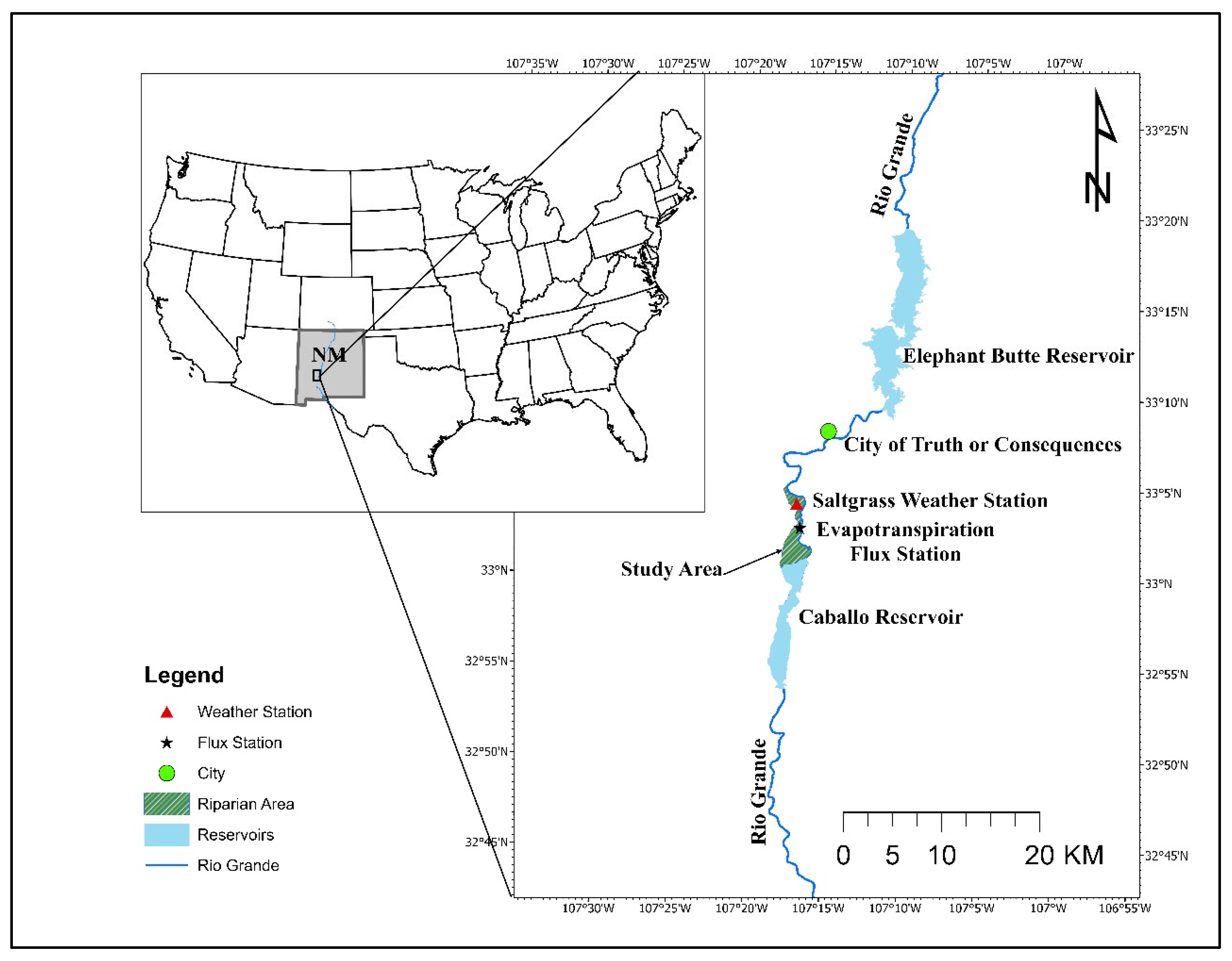
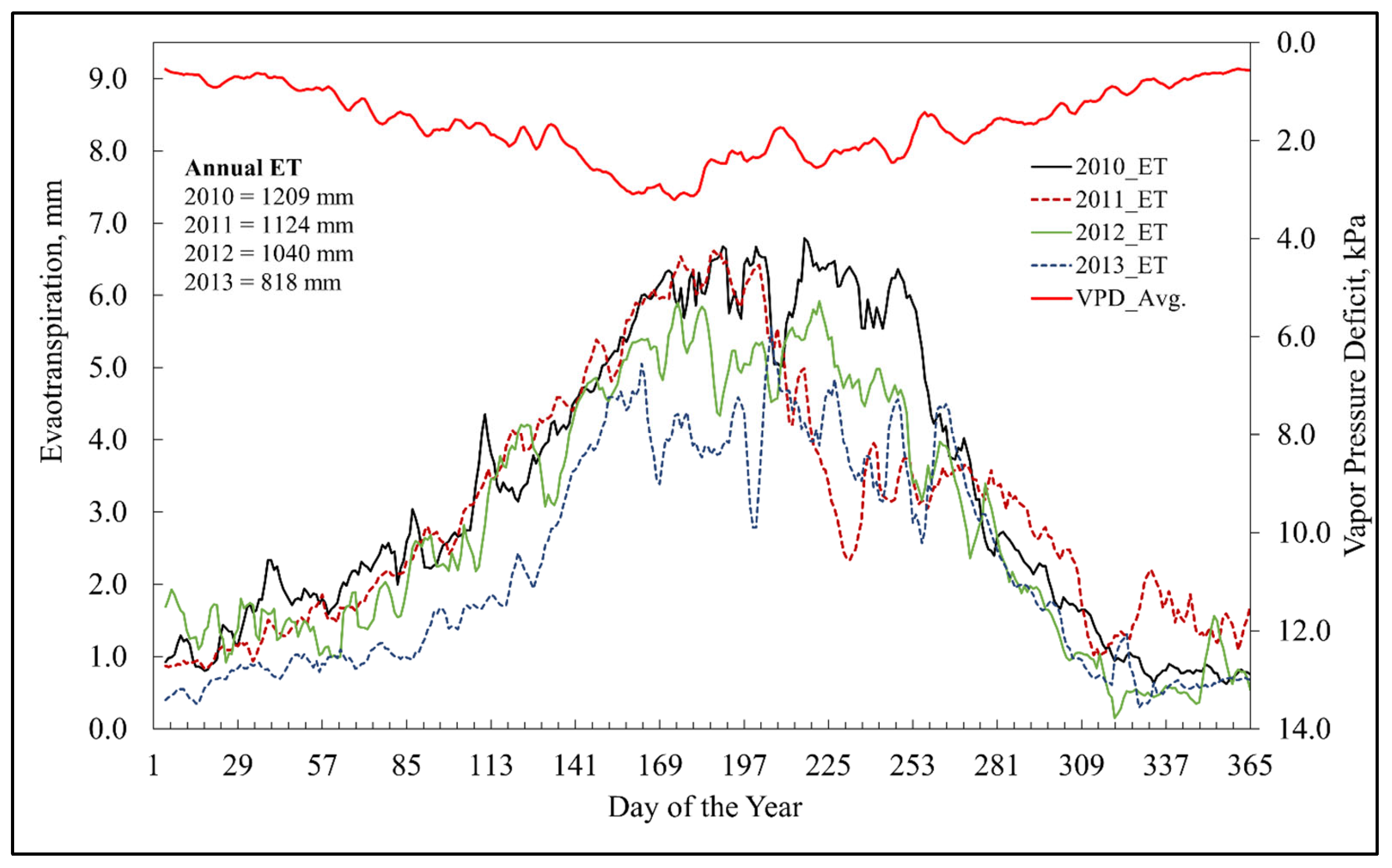
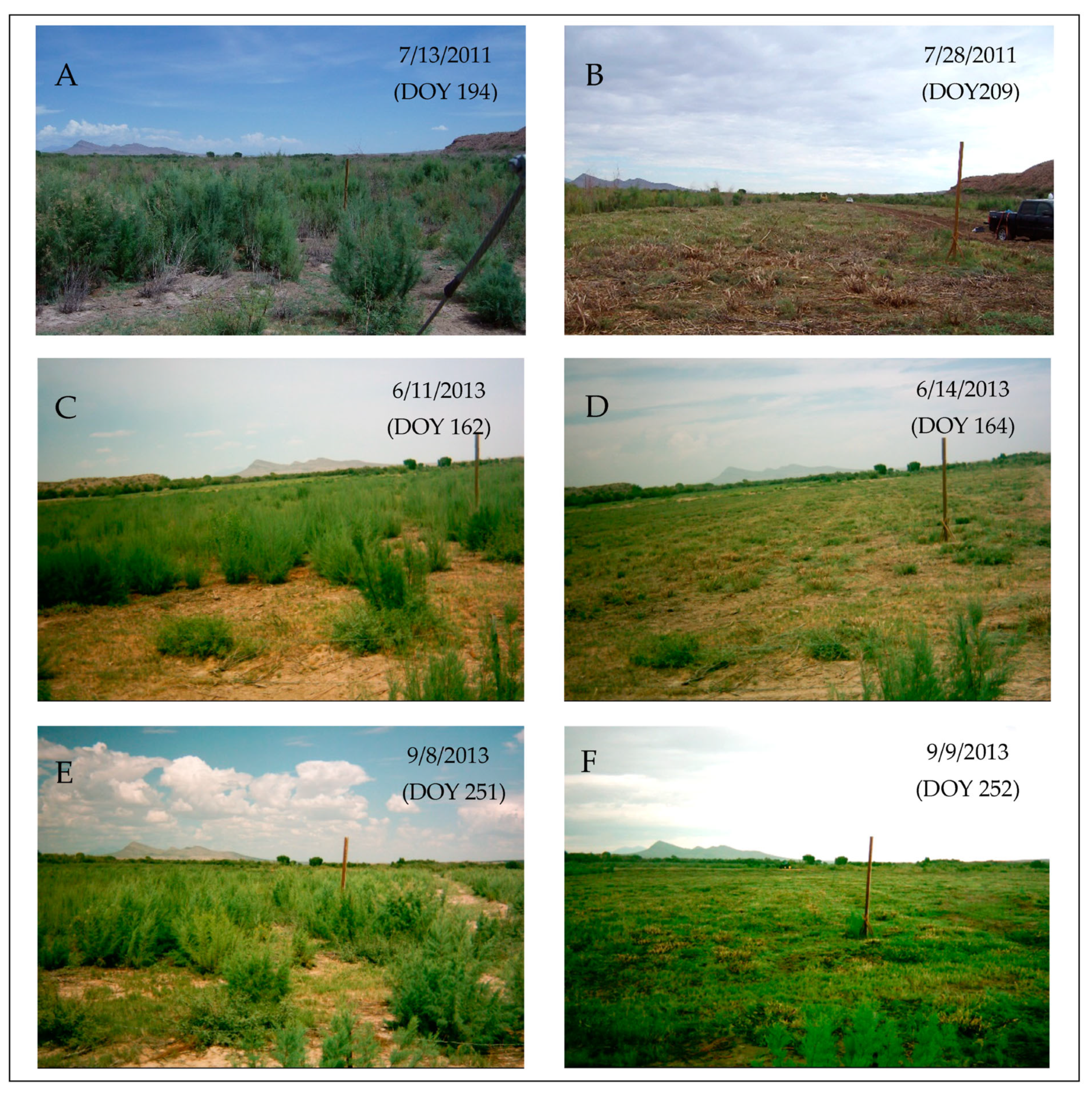
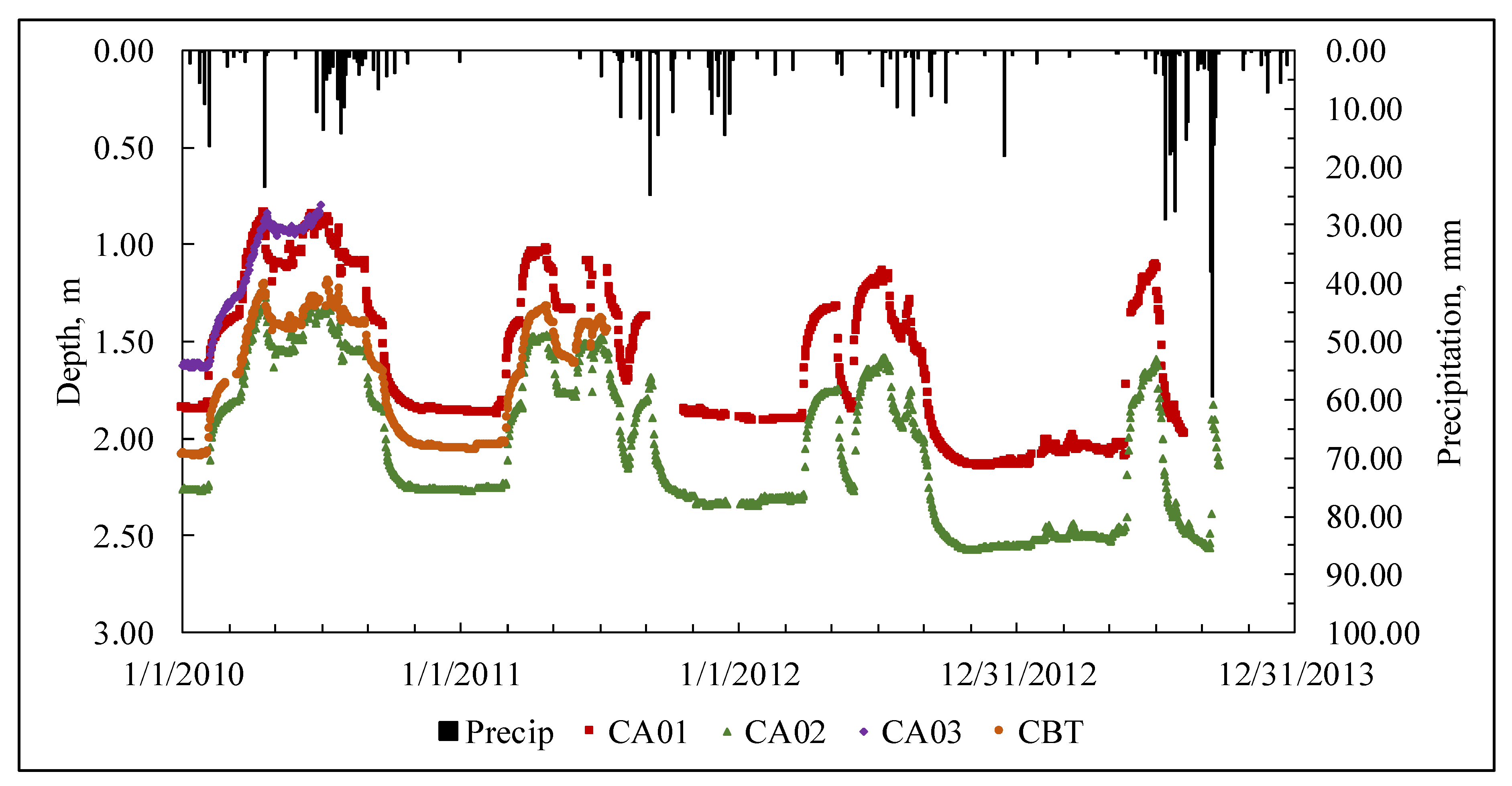
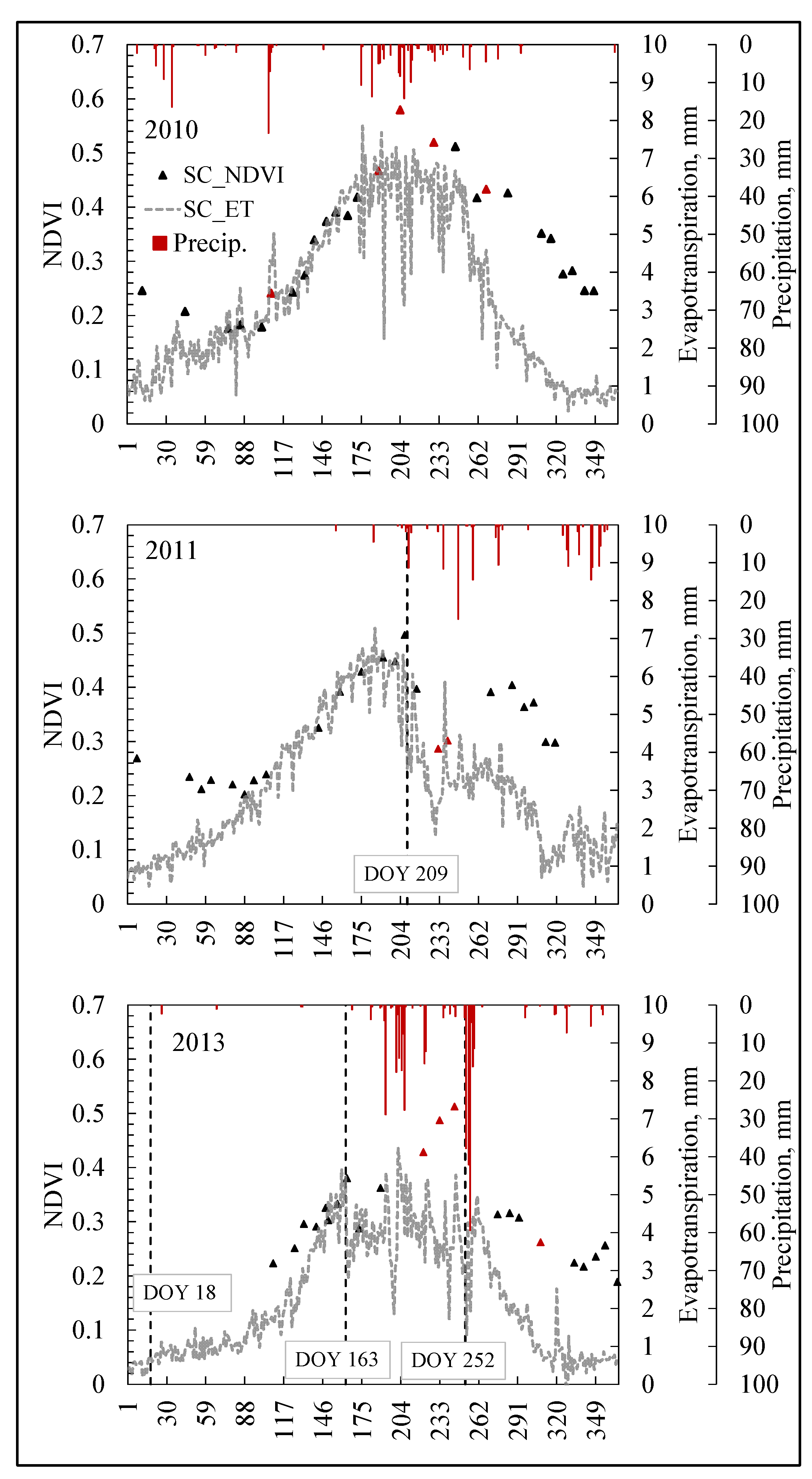
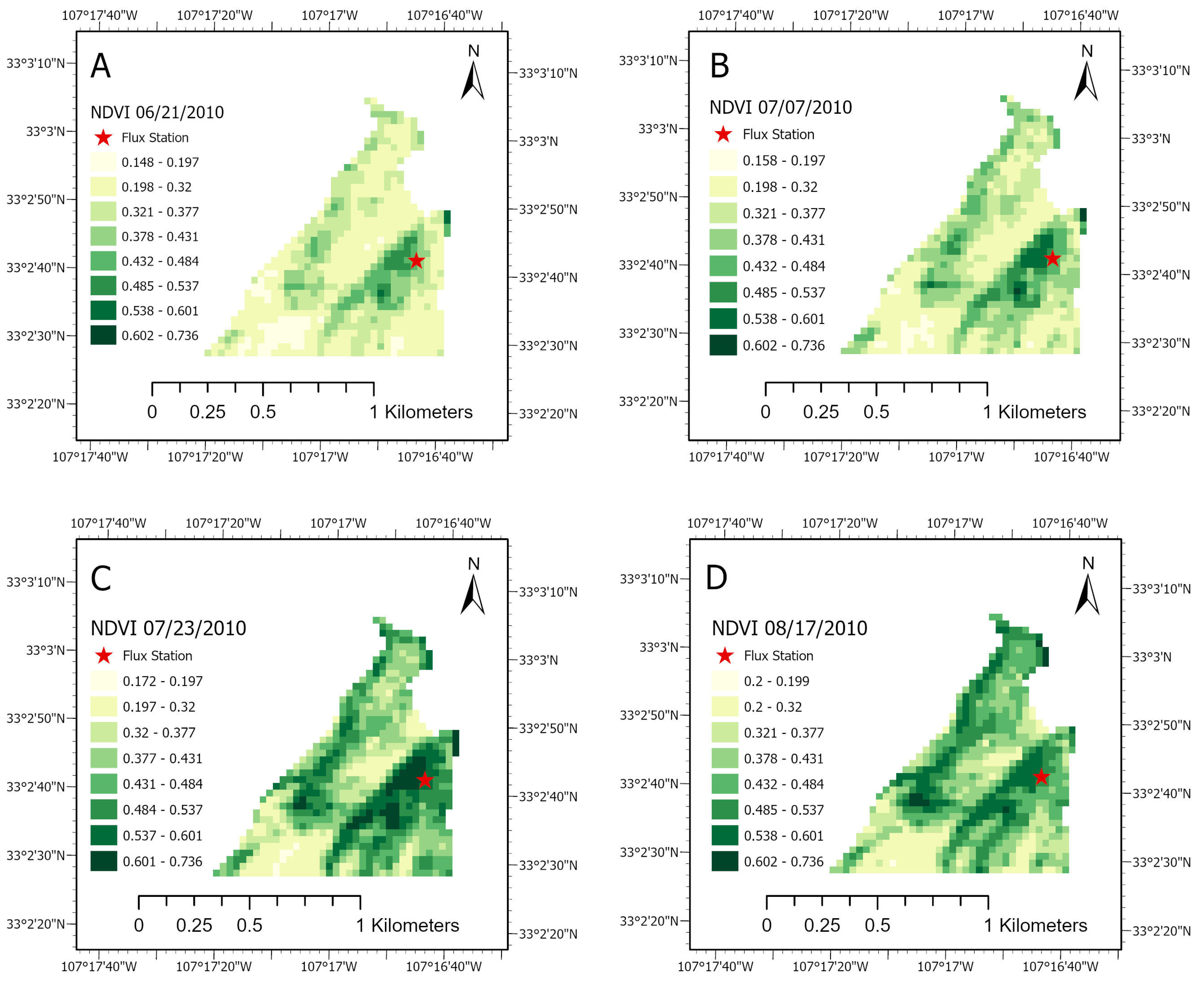
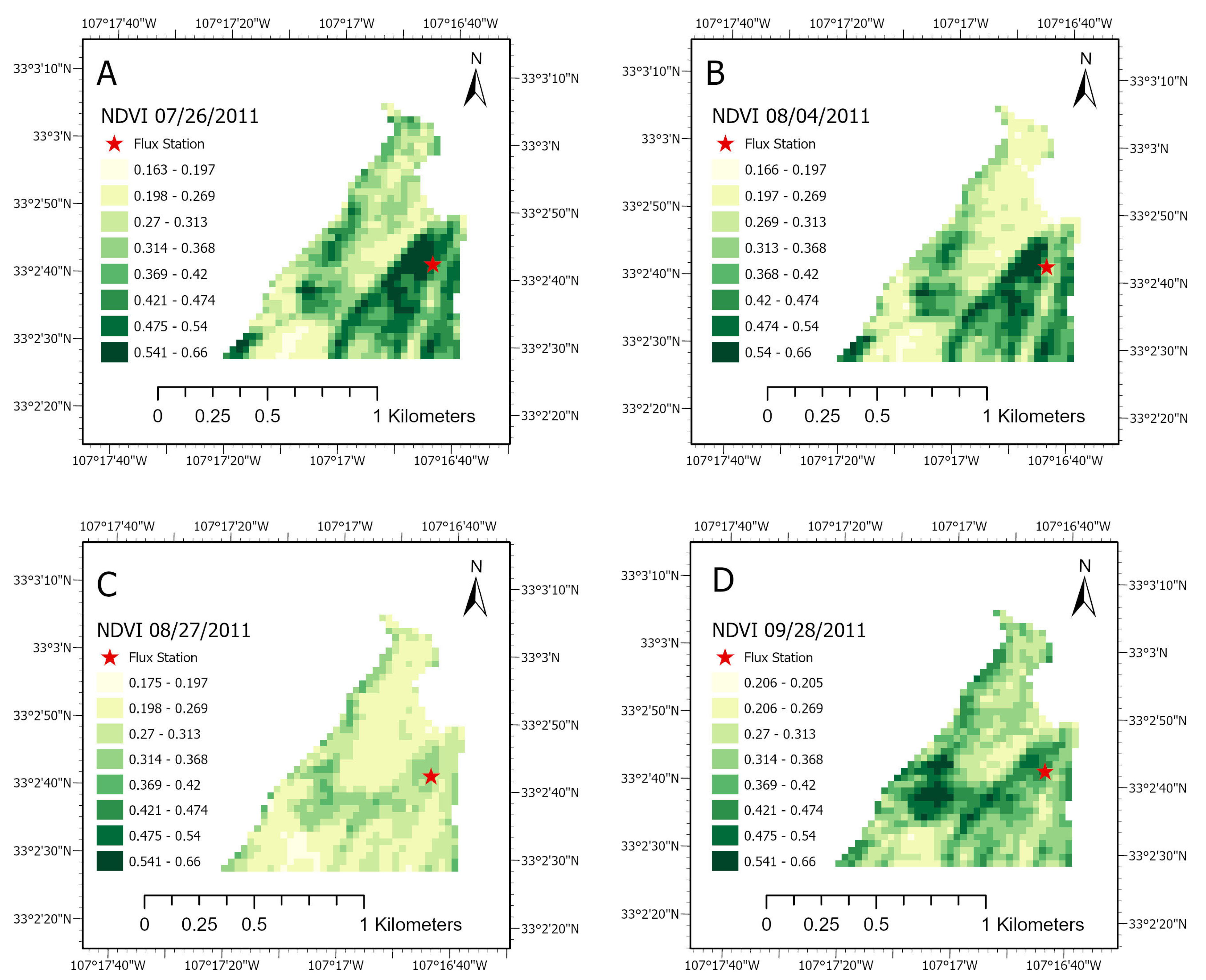
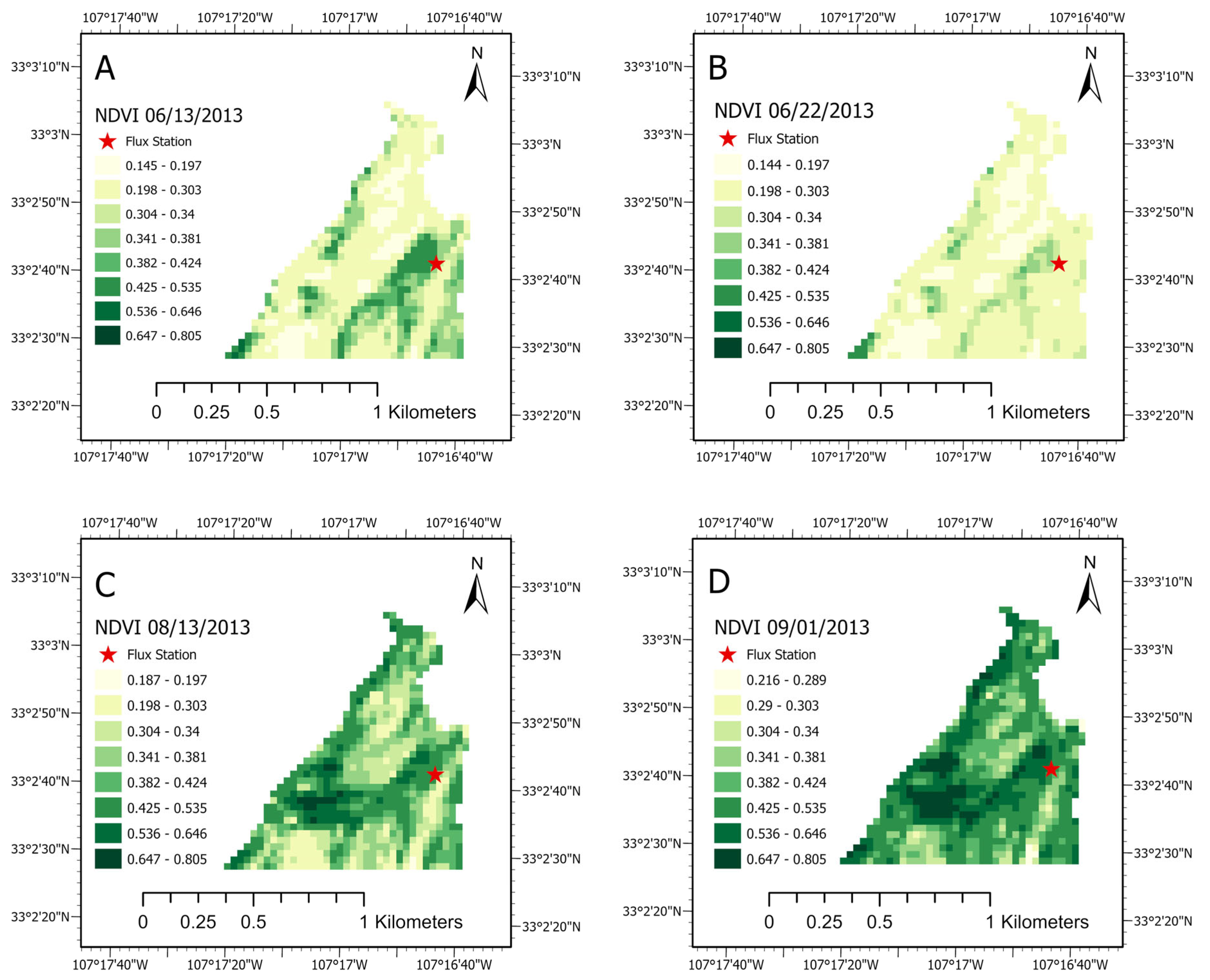
| Years of Comparison | Growing Stages † | Day of Year (DOY) | Intercept () | Linear () | Quadratic () | Cubic | p-Value | Cumulative ET Difference (mm) |
|---|---|---|---|---|---|---|---|---|
| 2011 vs. 2010 | Stage 1 | 1–208 | −0.0598 | 3.0110 | −1.2975 | −2.3871 | 0.0964 | 11.07 |
| Stage 2 | 209–270 | −2.1011 * | 6.8943 * | 7.7590 * | −1.3448 | <0.0001 | 129.32 | |
| Stage 3 | 271–365 | 0.5841 * | 1.3375 | 0.8782 | −0.4750 | 0.6949 | −55.63 | |
| Total | 84.76 | |||||||
| 2012 vs. 2011 | Stage 1 | 1–208 | −0.3221 * | −8.9818 * | 0.8205 | −2.4775 | <0.0001 | 66.63 |
| Stage 2 | 209–270 | 1.0432 * | −7.6742 * | −4.0379 * | 1.2676 | 0.0010 | −64.01 | |
| Stage 3 | 271–366 | −0.8995 * | −0.0116 | 0.3088 | −0.4920 | 0.9884 | 88.28 | |
| Total | 90.90 | |||||||
| 2013 vs. 2012 | Stage 1 | 1–163 | −0.8205 * | −0.6599 | 0.7909 | 5.4780 * | 0.0002 | 134.02 |
| Stage 2 | 164–252 | −0.9912 * | 2.9892 | 0.6791 | 2.5485 | 0.4611 | 92.24 | |
| Stage 3 | 253–366 | 0.0161 | −1.0759 | −1.5105 | 0.1738 | 0.7141 | −3.65 | |
| Total | 222.61 | |||||||
| 2013 vs. 2010 | Stage 1 | 1–163 | −1.0394 * | −2.8818 * | 4.2822 * | 1.4705 | <0.0001 | 169.70 |
| Stage 2 | 164–252 | −2.0871 * | 0.0703 | −2.7958 | −0.0405 | 0.6581 | 185.49 | |
| Stage 3 | 253–365 | −0.3602 * | 2.0588 | −1.9050 | 2.7277 * | 0.0374 | 36.08 | |
| Total | 391.27 | |||||||
| 2010 (N = 19) ρ = 0.6912, R2 = 48% | 2011 (N = 17) ρ = 0.7858, R2 = 62% | 2013 (N = 17) ρ = 0.5496, R2 = 30% | |
|---|---|---|---|
| 2010 (N = 19) | - | ||
| 2011 (N = 17) | p-value = 0.5659 | - | |
| 2013 (N = 17) | p-value = 0.5253 | p-value = 0.2416 | - |
| 2011 | 2013 | p-Value | |
|---|---|---|---|
| Stage 1 (N = 10) | ρ = 0.9595, R2 = 92% | ρ = 0.6704, R2 = 45% | 0.0084 |
| Stage 2 (N = 3) | ρ = 0.9691, R2 = 94% | ρ = −0.3496, R2 = 12% | 1.000 |
| Stage 3 (N = 4) | ρ = 0.6668, R2 = 44% | ρ = 0.7226, R2 = 52% | 0.9325 |
| Year | Temp._Max °C | N | Temp._Min °C | N | RH_ Max % | N | RH_Min % | N | Precip. mm | N |
|---|---|---|---|---|---|---|---|---|---|---|
| 2010 | 39.9 | 352 | −11.4 | 352 | 97.0 | 352 | 5.2 | 352 | 184 | 352 |
| 2011 | 39.5 | 353 | −21.0 | 353 | 97.4 | 353 | 3.6 | 353 | 181 | 353 |
| 2012 | 39.1 | 306 | −11.3 | 306 | 96.3 | 306 | 2.8 | 306 | 84 * | 306 |
| 2013 | 41.3 | 293 | −14.1 | 293 | 94.5 | 293 | 3.1 | 293 | 153 * | 293 |
Disclaimer/Publisher’s Note: The statements, opinions and data contained in all publications are solely those of the individual author(s) and contributor(s) and not of MDPI and/or the editor(s). MDPI and/or the editor(s) disclaim responsibility for any injury to people or property resulting from any ideas, methods, instructions or products referred to in the content. |
© 2023 by the authors. Licensee MDPI, Basel, Switzerland. This article is an open access article distributed under the terms and conditions of the Creative Commons Attribution (CC BY) license (https://creativecommons.org/licenses/by/4.0/).
Share and Cite
Solis, J.C.; Bawazir, A.S.; Tanzy, B.F.; Luthy, R.G.; Jeon, S. Inducing Evapotranspiration Reduction in an Engineered Natural System to Manage Saltcedar in Riparian Areas of Arid Environments. Water 2024, 16, 53. https://doi.org/10.3390/w16010053
Solis JC, Bawazir AS, Tanzy BF, Luthy RG, Jeon S. Inducing Evapotranspiration Reduction in an Engineered Natural System to Manage Saltcedar in Riparian Areas of Arid Environments. Water. 2024; 16(1):53. https://doi.org/10.3390/w16010053
Chicago/Turabian StyleSolis, Juan C., A. Salim Bawazir, Brent F. Tanzy, Richard G. Luthy, and Soyoung Jeon. 2024. "Inducing Evapotranspiration Reduction in an Engineered Natural System to Manage Saltcedar in Riparian Areas of Arid Environments" Water 16, no. 1: 53. https://doi.org/10.3390/w16010053
APA StyleSolis, J. C., Bawazir, A. S., Tanzy, B. F., Luthy, R. G., & Jeon, S. (2024). Inducing Evapotranspiration Reduction in an Engineered Natural System to Manage Saltcedar in Riparian Areas of Arid Environments. Water, 16(1), 53. https://doi.org/10.3390/w16010053






